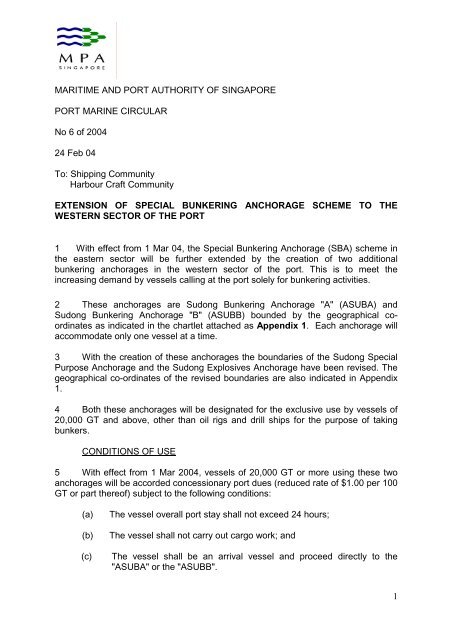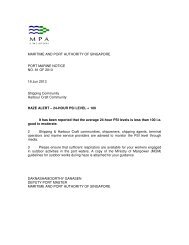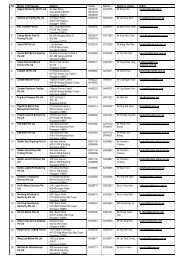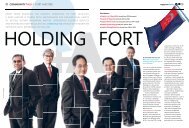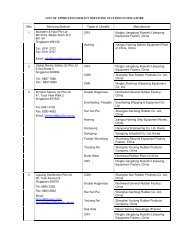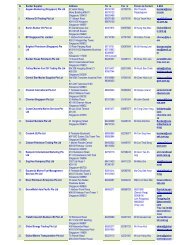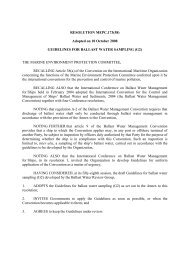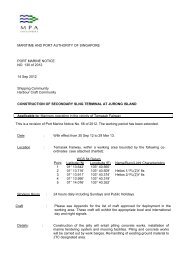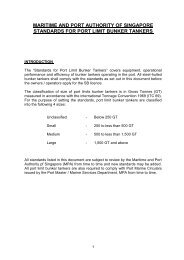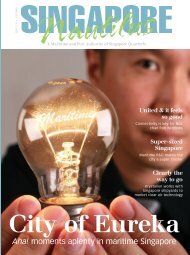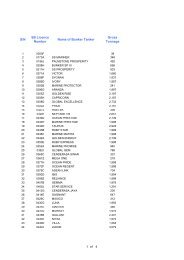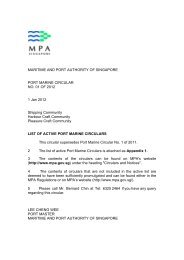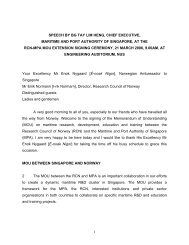MARITIME AND PORT AUTHORITY OF SINGAPORE - MPA
MARITIME AND PORT AUTHORITY OF SINGAPORE - MPA
MARITIME AND PORT AUTHORITY OF SINGAPORE - MPA
You also want an ePaper? Increase the reach of your titles
YUMPU automatically turns print PDFs into web optimized ePapers that Google loves.
<strong>MARITIME</strong> <strong>AND</strong> <strong>PORT</strong> <strong>AUTHORITY</strong> <strong>OF</strong> <strong>SINGAPORE</strong><br />
<strong>PORT</strong> MARINE CIRCULAR<br />
No 6 of 2004<br />
24 Feb 04<br />
To: Shipping Community<br />
Harbour Craft Community<br />
EXTENSION <strong>OF</strong> SPECIAL BUNKERING ANCHORAGE SCHEME TO THE<br />
WESTERN SECTOR <strong>OF</strong> THE <strong>PORT</strong><br />
1 With effect from 1 Mar 04, the Special Bunkering Anchorage (SBA) scheme in<br />
the eastern sector will be further extended by the creation of two additional<br />
bunkering anchorages in the western sector of the port. This is to meet the<br />
increasing demand by vessels calling at the port solely for bunkering activities.<br />
2 These anchorages are Sudong Bunkering Anchorage "A" (ASUBA) and<br />
Sudong Bunkering Anchorage "B" (ASUBB) bounded by the geographical coordinates<br />
as indicated in the chartlet attached as Appendix 1. Each anchorage will<br />
accommodate only one vessel at a time.<br />
3 With the creation of these anchorages the boundaries of the Sudong Special<br />
Purpose Anchorage and the Sudong Explosives Anchorage have been revised. The<br />
geographical co-ordinates of the revised boundaries are also indicated in Appendix<br />
1.<br />
4 Both these anchorages will be designated for the exclusive use by vessels of<br />
20,000 GT and above, other than oil rigs and drill ships for the purpose of taking<br />
bunkers.<br />
CONDITIONS <strong>OF</strong> USE<br />
5 With effect from 1 Mar 2004, vessels of 20,000 GT or more using these two<br />
anchorages will be accorded concessionary port dues (reduced rate of $1.00 per 100<br />
GT or part thereof) subject to the following conditions:<br />
(a) The vessel overall port stay shall not exceed 24 hours;<br />
(b) The vessel shall not carry out cargo work; and<br />
(c) The vessel shall be an arrival vessel and proceed directly to the<br />
"ASUBA" or the "ASUBB".<br />
1
CONDITIONS FOR PILOT EXEMPTION<br />
6 Vessels of 20,000 GT or more using these two anchorages may be granted<br />
pilot exemption. To qualify for pilotage exemption the following conditions shall be<br />
complied with:<br />
(a) The maximum arrival draft of the vessel should not exceed 11.5m; and<br />
(b) The vessel must not be a Liquefied Petroleum Gas (LPG) vessel,<br />
Liquefied Natural Gas (LNG) vessel or a Chemical tanker.<br />
7 The information to assist shipmaster in planning the passage of vessel to the<br />
bunkering anchorages in the western sector of the port is shown in Appendix 2. The<br />
tidal predictions for the area are also available under the Singapore Maritime Portal<br />
web-site (http://www.singaporemaritimeportal.com) - "Digital Tidal Atlas". Masters of<br />
vessels are advised to familiarise themselves with the approach and to take note of<br />
the tidal pattern of the area. Masters who are not familiar with the waters in the area<br />
are advised to engage the services of a pilot.<br />
RE<strong>PORT</strong>ING PROCEDURE<br />
8 Owners, agents or masters of arriving vessels proceeding to the "ASUBA" or<br />
"ASUBB" under this scheme are required to confirm with the Vessel Traffic<br />
Information Service (VTIS) at least three to four hours before the vessel arrives on<br />
the availability of anchorage space. The confirmation may be done by any of the<br />
following means:<br />
VTIS: Ch 10 (If arriving from the East)<br />
Ch 73 (If arriving from the West)<br />
Tel : 6325-2493 (Duty Officer Port Operations Control Centre )<br />
Fax : 6224-5776.<br />
9 In the event that the anchorages are occupied, VTIS will then inform the<br />
vessel to use the appropriate alternative anchorages in the western or eastern sector<br />
of the port.<br />
NAVIGATION CHARTS<br />
10 Chart corrections depicting the limits of the bunkering anchorages have been<br />
promulgated in Singaporean Notices to Mariners Monthly Edition No 3 of 2004.<br />
Masters are advised to insert the limits of the anchorages on the affected charts.<br />
11 Please contact Capt Donald D’Cruz Tel: 6325-2460 on pilotage matters or Mr<br />
Tan Lay Thok at Tel: 6325-2470 on port dues matters, if you need further<br />
clarification.<br />
EDMUND WEE<br />
for <strong>PORT</strong>MASTER<br />
<strong>MARITIME</strong> <strong>AND</strong> <strong>PORT</strong> <strong>AUTHORITY</strong> <strong>OF</strong> <strong>SINGAPORE</strong><br />
2
Appendix 2<br />
INFORMATION TO ASSIST SHIPMASTERS IN PLANNING THE PASSAGE <strong>OF</strong><br />
VESSELS TO THE BUNKERING ANCHORAGES IN THE WESTERN SECTOR <strong>OF</strong><br />
THE <strong>PORT</strong><br />
Pilotage<br />
1 Pilotage exemption may be granted for vessels with arrival drafts not<br />
exceeding 11.5 metres. Masters who are not familiar with the waters in the area are<br />
advised to engage the services of a pilot.<br />
2 Vessels with drafts of more than 11.5 metres are required to engage the<br />
services of authorised pilots to navigate in and out of these anchorages. Vessels<br />
with drafts of more than 16.5 metres would be diverted to other suitable anchorages<br />
for bunkering activities.<br />
Tidal information<br />
3 Current information at half-hour intervals is available at the Singapore<br />
Maritime Portal (SMP) website under the title of “Digital Tidal Atlas”. The address for<br />
SMP is:<br />
http://www.singaporemaritimeportal.com<br />
Owners and agents may download the relevant pages and sent them through e-mail<br />
or fax, if their shipmasters are unable to access the Internet.<br />
4 As the simulated current predictions may vary from the actual current, a realtime<br />
current meter will be installed by 1 Apr 2004 in the vicinity of the anchorages.<br />
On arrival, shipmasters may contact “Port Operations West” (on VHF Channel 68)<br />
for a real-time reading of the current meter. This would provide an indication of the<br />
direction and rate of the current flow that may, at times, exceed 2.5 knots.<br />
Approach to the anchorages<br />
5 Whilst arriving and departing from the anchorage, shipmasters are advised to<br />
plan their approach in advance taking into consideration, amongst other factors, the<br />
flow of the current, the depth of water and their effect on the vessels. Attention is<br />
drawn to the presence of two gas pipelines west of the Sudong Bunkering<br />
Anchorage ‘A’. Shipmasters are advised to ascertain the vessel’s position prior to<br />
letting go the anchor in the anchorage.<br />
(a) West-Going Tidal Stream<br />
Strong currents may be expected from the Sinki Fairway, Selat Sudong<br />
and Selat Pawai during the westgoing tidal stream. These streams may<br />
set the vessel towards Raffles Shoal and into the westbound lane of the<br />
traffic separation scheme (TSS). Masters of vessels are advised to<br />
carefully monitor the vessel’s position when proceeding to the<br />
bunkering anchorages.<br />
3
At anchor<br />
(b) East-Going Tidal Stream<br />
(i) A vessel approaching the bunkering anchorages from the west<br />
during the eastgoing stream will experience a stern current. Masters<br />
of vessels arriving at the port from the west are therefore advised to<br />
continue along the eastbound lane of the Singapore Strait TSS and<br />
approach the anchorages from the east stemming the current. Prior<br />
to crossing the westbound traffic lane the vessel should notify VTIS<br />
Central on VHF Ch 14.<br />
(ii) A vessel with good manoeuvring characteristics and equipped with<br />
a good working bow-thruster, may approach the anchorages from<br />
the west if the tidal stream is weaker. The Master should however<br />
exercise caution and approach at a speed that will allow the vessel<br />
to stop in time, swing around and safely anchor.<br />
6 Whilst at anchor, the vessel should pay out sufficient scope of cable (at least<br />
six (6) shackles of chain in the water) and maintain an anchor watch at all times. For<br />
the information of Masters, squalls called ‘Sumatras’ are common from April to<br />
November during the Southwest Monsoon and inter-monsoon periods. They are<br />
generally experienced in the pre-dawn and early hours between 0300hrs and<br />
0900hrs.<br />
Live-firing Area<br />
7 The New Southern Islands Live Firing Area is a restricted area. Masters of<br />
vessels proceeding to the Sudong bunkering anchorages are to keep out of this<br />
area. As low-flying aircraft operate in the vicinity of the live firing area, the master,<br />
owners and agents of vessels with heights exceeding 75 metres must notify the<br />
RSAF - Air Operation Centre when in the western sector of the port via facsimile<br />
(Fax No. 6760-5521).<br />
***************<br />
4


